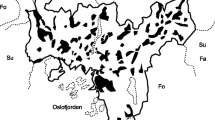Abstract
The relation between two species of bats, the pipistrelle (Pipistrellus pipistrellus (Schreber, 1774)) and the serotine (Eptesicus serotinus (Schreber, 1774)) and linear landscape elements such as hedgerows, tree lines and tree lanes was studied in an agricultural area in The Netherlands. The pipistrelle was observed almost entirely close to landscape elements, while serotines more frequently crossed fields and meadows. Serotine activity in these open areas was, however, negatively related to the distance to a landscape element and to windspeed.
On a landscape scale the results indicate a more than proportional positive relation between the density of serotine bats and the density of linear landscape elements, whereas this relation was only proportional in the case of the pipistrelle. It is argued, that landscapes with a high density of linear elements have a surplus value for serotine bats.
Three possible functions of linear elements for bats (orientation clues, foraging habitat and shelter from wind and/or predators) are discussed. Any of these may explain the results of this study.
Similar content being viewed by others
References
Bateman, G.C. and Vaughan, T.A. 1974. Nightly activities of mormoopid bats. J Mammal 55(1): 45–65.
Bell, W.J. 1991. Searching behaviour: The behavioural ecology of finding resources. Chapman and Hall, London.
Forman, R.T. and Baudry, J. 1984. Hedgerows and hedgerow networks in landscape ecology. Environ Manage 8: 495–510.
Getz, L.L., Cole, F.R. and Gates, D.L. 1978. Interstate roadsides as dispersal routes forMicrotis pennsylvanicus. J Mammal 59: 208–212.
Henderson, M.T., Merriam, G. and Wegner, J. 1985. Patchy environments and species survival: chipmunks in an agricultural mosaic. Biol Conserv 31: 95–105.
Helmer, W. 1983. Boombewonende watervleermuizenMyotis daubentoni (Kuhl, 1817) in het rijk van Nijmegen. Lutra 26: 1–11.
Hoare, L.R. 1991. The diet ofPipistrellus pipistrellus during the prehibernal period. J Zool, London 225: 665–670.
Kalko, E.K.V. and Schnitzler, H.-U. 1993. Plasticity in echolocation signals of European pipistrelle bats in search flight: implications for habitat use and prey detection. Behav Ecol Sociobiol 33: 415–428.
Kapteyn, K. and Verheggen, L. 1990. Van bosje tot bosje: verband tussen vleermuizen (Chiroptera), begroeiing en landschapsstructuur in Zuid-Limburg. Report no. 1081, Nature Conservation Department, Agricultural University Wageningen.
Karg, J. and Ryszkowski, L. 1985. Influence of agricultural landscape configuration on the density and stratification of insect flight. Archiv für Naturschutz und Landschaftsforschung 25(4): 247–255.
Labee, A.H. and Voûte, A.M. 1983. The diet of a nursery colony of the serotine batEptesicus serotinus (Schreber, 1774) in the Netherlands. Lutra 26: 12–19.
Lewis, T. 1969a. The diversity of the insect fauna in a hedgerow and neighbouring fields. J Appl Ecol 6: 453–458.
Lewis, T. 1969b. The distribution of flying insects near a low hedgerow. J Appl Ecol 6: 443–452.
Lewis, T. and Dibley, G.C. 1970. Air movement near windbreaks and a hypothesis of the mechanism of the accumulation of airborne insects. Ann Appl Biol 66: 477–484.
Limpens, H.J.G.A. and Kapteyn, K. 1991. Bats, their behaviour and linear landscape elements. Myotis 29: 63–71.
Limpens, H.J.G.A., Winden, A. van and Mostert, K. 1989. Bats (Chiroptera) and linear landscape elements. Lutra 32(1): 1–20.
Miller, L.A. ad Degn, H.J. 1981. The acoustic behavior of four species of vespertilionid bats studied in the field. J Comp Physiol 142: 67–74.
Mueller, H. and Emlen, J.T., Jr. 1957. Homing in bats. Science 126: 307–308.
Neuweiler, G. 1990. Auditory adaptations for prey capture in echolocating bats. Physiol Rev 70(3): 615–641.
Neuweiler, G. and Fenton, M.B. 1988. Behaviour and foraging ecology of echolocating bats.In Animal Sonar. Life Sciences. pp. 535–550. Edited by P.E. Nachtigall and P.W.B. Moore. Plenum, New York.
Opdam, P., Rijnsdijk, G. and Hustings, F. 1985. Bird communities in small woods in an agricultural landscape: effects of area and isolation. Biol Conserv 34: 333–352.
Racey, P. and Swift, S. 1985. Feeding ecology ofPipistrellus pipistrellus (Chiroptera: Vespertilionidae) during pregnancy and lactation. I. Foraging behaviour. J Animal Ecol 54: 205–215.
Rieger, I., Walzthöny, D. and Adler, H. 1990. Wasserfledermäuse benutzen Flugstrassen. Mitteilungen Naturforschungs Gesellschaft Schaffhausen 35: 37–68.
Robinson, M.F. and Stebbings, R.E. 1993. Food of the serotine bat,Eptesicus serotinus — is faccal analysis a valid qualitative and quantitative technique? J Zool, London 231: 239–248.
Speakman, J.R. 1991. The impact of predation by birds on bat populations in the British Isles. Mammal Rev 21(3): 123–142.
Stones, R.C. and Branick, L.P. 1969. Use of hearing in homing by two species ofMyotis bats. J Mammal 50(1): 157–160.
Sullivan, C.M., Shiel, C.B., McAney, C.M. and Fairley, J.S. 1993. Analysis of the diets of Leisler’sNyctalus leisleri, Daubenton’sMyotis daubentoni and pipistrellePipistrellus pipistrellus bats in Ireland. J Zool, London 231: 656–663.
Swift, S.M., Racey, P.A. and Avery, M.I. 1985. Feeding ecology ofPipistrellus pipistrellus (Chiroptera: Vespertilionidae during pregnancy and lactation. II. Diet. J Anim Ecol 54: 217–225.
Taylor, L.R. 1974. Insect migration, flight periodicity and the boundary layer. J Anim Ecol 43: 225–238.
Van Dorp, D. and Opdam, P.F.M. 1987. Effects of patch size, isolation and regional abundance on forest bird communities. Landscape Ecol 1(1): 59–73.
Verboom, B. and Apeldoorn, R. van 1990. Effects of habitat fragmentation on the red squirrel,Sciurus vulgaris L. Landscape Ecol 4(2/3): 171–176.
Wegner, J.F. and Merriam, G. 1979. Movements by birds and small mammals between wood and adjoining farmland habitats. J Appl Ecol 16: 349–358.
Williams, T.C., Williams, J.M. and Griffin, D. 1966. The homing ability of the neotropical batPhyllostomus hastatus, with evidence for visual orientation. Anim Behav 14: 486–473.
Author information
Authors and Affiliations
Rights and permissions
About this article
Cite this article
Verboom, B., Huitema, H. The importance of linear landscape elements for the pipistrellePipistrellus pipistrellus and the serotine batEptesicus serotinus . Landscape Ecol 12, 117–125 (1997). https://doi.org/10.1007/BF02698211
Issue Date:
DOI: https://doi.org/10.1007/BF02698211




